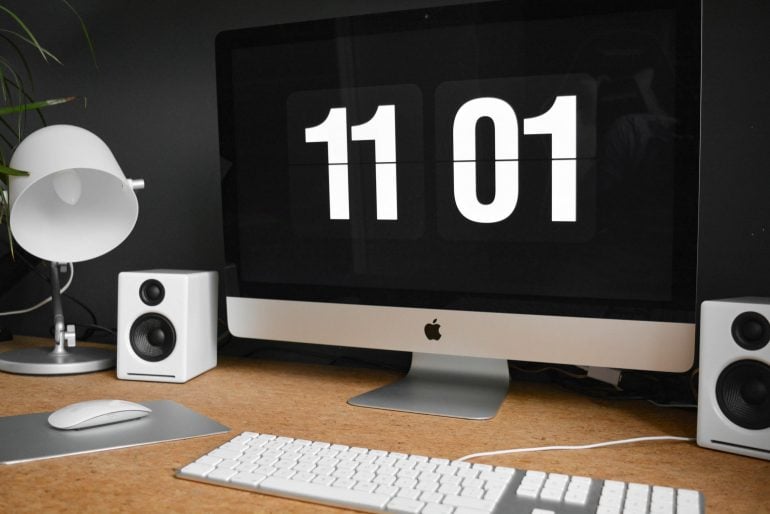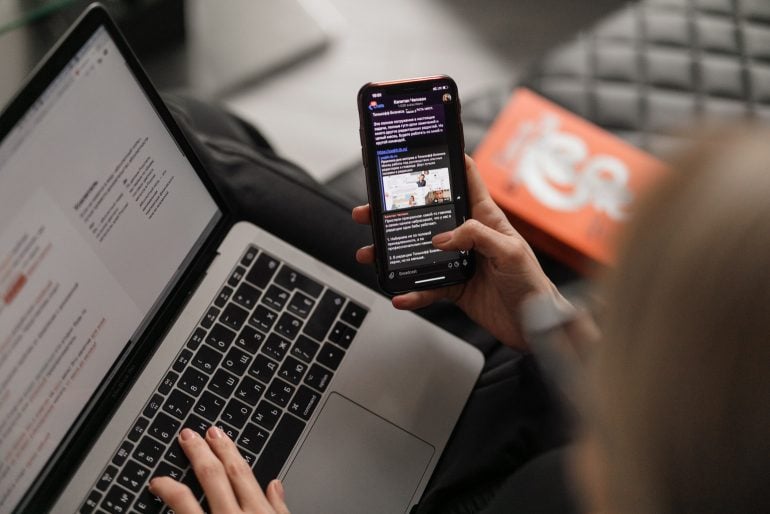-
Screen Time for Mac: Everything You Need to Know
 Image source: Damian Patkowski
Image source: Damian PatkowskiBeing aware of how we spend our time can help us be more productive and focused. By revealing patterns of behavior, it can also help us to find a balance between the time we spend on different activities. But how do we know where our time is going? Using a time tracking tool such as Screen Time for Mac is a useful place to start. (But, it’s not the only option!)
Screen Time was an iPhone and iPad feature first, but it’s been available across all Apple devices, including Macs, for some time. Mac Screen Time first came out with macOS 10.15 Catalina, and has continued to be available on all subsequent versions, including macOS 11 Big Sur, macOS 12 Monterey and macOS 13 Ventura.
-
The 4 Day Week – Halfway Trial Results and Participating Countries

There is a lot of talk around the six-month trial of a 4-day work week in the United Kingdom. The trial is run by the 4 Day Week Global Foundation who funds research into 4-day week practices, the future of work and workplace wellbeing. The UK trial is in partnership with Autonomy and 4 Day Week UK.
What is the 4 Day Week?
The 4 Day Week Global Foundation is a not-for-profit community established by Andrew Barnes and Charlotte Lockhart. It aims to “provide a platform for like-minded people who are interested in supporting the idea of the 4 day week as a part of the future of work”. A future where workers get an extra day off per week with no reduction in pay. This is based on the 100-80-100™ model. Which stands for 100% pay, for 80% of the time and a commitment to maintain at least 100% of the output.
The UK Trial Halfway Results
The UK 6-month trial kicked off in June 2022 and will conclude in November 2022. The full pilot programme started in February this year with information sessions and a call to sign up. More than 70 UK organisations signed up for the 6-month trial with the halfway point results published last month. Some of these results include:
-
Time Management & Mental Health – Create the work-life balance you need

In support of this year’s World Mental Health Day theme ‘Making Mental Health & Well-Being for All a Global Priority’, we have a unique roundup of articles to help you create a healthy work-life balance and build the life you want.
You may be a freelancer, consultant, entrepreneur, part of a team or manage a team – whoever you are, life is busy. Our lives actually seem to be getting even more and more busy; and it’s getting more difficult to keep on top of everything we need to do.
Did you know that time management isn’t about getting everything done, but rather about getting the important things done? Psychology Today refers to time management as “a skill necessary for achieving a better quality of life. By managing your time in a more efficient way, not only will you get the right things done, but you’ll also have enough time to relax, de-stress and breathe more freely.”
Discover how you can improve your time management skills for a better quality of life with this collection of Timing articles.
- Timing Management Tips: How to Work Less?
- Time Scarcity Can Be Beaten! Here’s How to Break Free
- Mental Health Challenges as a Freelancer — and How to Cope
- How to Recognize Toxic Productivity With Time Tracking
- 10 Ways to Overcome Time Anxiety Using Time Tracking
- Why (and How) You Should Schedule Time For Your Relationship
These articles include tips on how to work less, understand what some of the biggest time management challenges are, as well as helpful references and apps that can help you create the life you want.
-
Screen Time on Your iPhone, iPad and Mac: The Definitive Guide in 2025

It probably goes without saying, but we couldn’t live without them: our digital devices are arguably among the most indispensable parts of our personal and professional lives, connecting us to friends, family, colleagues, and the rest of the world for a multitude of reasons numerous times a day.
How many times a day exactly? A recent survey found that US smartphone users checked their phones an average of once every four minutes in 2021, a dramatic increase from a 2019 study, which put this figure at once every 10 minutes. Whatever our habits, if we look at our Screen Time report, many of us will likely find that we’re spending at least a month a year on our phones—maybe more.
But is every one of these instances worthwhile? Are we using our time productively, to learn, work and be entertained, or are we simply whiling away the hours? When it comes to our phones, tablets and computers, where is the line between help and hindrance, and can being aware of our screen time help us to manage our phone usage better?
Let’s look at how monitoring the apps you’re using through Screen Time on iPhone can help you to be more aware of your time, and boost your productivity in the process. We’ll also ask whether there are any alternatives for you to consider. (Spoiler alert: there are!)
-
How to Recognize Toxic Productivity With Time Tracking

Image source: cookie_studio
It is 8 AM on Saturday, and you already feel anxious because you have a lengthy list of tasks you want to complete. Your team told you to take some time off, but you can’t seem to slow down. Your mind is always racing, so you can’t relax.
This is what it’s like when toxic productivity takes over your life. Your mindset makes you believe that your worth is determined by how much you accomplish. If you are not constantly working, you feel useless. Suffering from toxic productivity can lead to depression, anxiety, and burnout.
Tracking how much time you spend on tasks and projects is a great way to reduce toxic productivity as you can ensure you’re not wasting time on unimportant work. It helps you reach your goals faster and with less stress. You can use your downtime to rest and recharge to become even more productive when you return to work.
Automatic time tracking tools, such as Timing for macOS users, help you track how much time you spend on various tasks to see which ones are taking up most of your time.
Timing helps you focus on what’s important instead of wasting time on non-essential tasks. It shows you a detailed breakdown of where your time goes throughout the day to identify any blind spots in your workflow, so you can adjust accordingly.
When you keep track of your time, you’ll be able to identify patterns in your work day and understand how to improve your productivity and efficiency.
Timing also helps you gain a sense of control over your work life and provides you time tracking data you can use for both personal and professional development. To see how it works, download Timing today and start your 30-day free trial.
Toxic productivity and being productive are two completely different things. In today’s article, we will provide the information you need to recognize and overcome this challenge. We will also explain how Timing helps you reduce the need for constant productivity. Let’s start with some basics.
Read More… -
The Importance of Time Recording for Team Efficiency
Many teams agree that time recording is essential in improving productivity and efficiency. However, they usually avoid tracking work hours. It feels like a burden to record time manually since it disrupts their work days, takes up additional time, and results in inaccurate reports.
In the long run, avoiding time recording will do far more harm than good for your team since the average employee faces more than 50 distractions daily, while multitasking makes them 40% less productive.
You can use automatic time tracking software such as Timing to overcome these challenges and improve operational efficiency and team effectiveness. This can facilitate team coordination in general.
Timing automatically tracks time for your team, helping them do their jobs without interruptions. They can freely switch between tasks without worrying about starting and stopping timers.
Timing enables you to understand team capacity, improve time, resources, project management, and increase project profitability by keeping your team on track.
Timing also preserves your team members’ privacy by showing the aggregate project time record without personal details. You can get an overview of the time spent on each project to make necessary improvements. To see how it works, download Timing and start tracking time with a 30-day free trial.
In today’s article, we will explain the importance of time recording for team efficiency and show how to use Timing to achieve your business goals. Let’s start with some general information on time recording.
Read More… -
How to Track Employee Time Effectively: Manual vs Automatic Time Tracking
To track or not to track… That was the question.
Not anymore.
To track manually or automatically – that is the question of today’s importance. Because of poor time tracking habits and, consequently, untracked time, US companies lose $8.8 billion per day.

Image author: Annie Spratt
Businesses still face burdensome disagreements around employee work hours and struggle to decide how to monitor the latter efficiently. Let’s take the controversy around old-fashioned paper timesheets vs digitally-driven solutions for worker time monitoring.
Are you still using paper timesheets or have you already switched to digital methods and productivity apps?
You’ll definitely change your mind in favor of automatic tools after reading this article. Dive in.
-
10 Ways to Improve Poor Time Management
Poor time management is detrimental to productivity and brings more stress to work. It is proven to affect work-life balance and relationships with colleagues. Statistics show that the average person tries to solve this problem using 13 different time management methods.
Timing, our automatic time tracking tool for macOS users, helps you overcome this issue. It records your time down to the second and helps you become more productive and efficient.
With Timing, you get reports on your activities which allow you to identify distractions and take measures to improve your time management. To start tracking your time automatically, without having to remember to start and stop timers manually, download Timing today and use a 30-day free trial to test all features.
Today we will discuss the signs that tell if you fall victim to common time management mistakes. We will also give you ten tips to fix these issues, become more productive and efficient, reduce stress, and improve your overall well-being.
We will also explain how time tracking helps identify time management problems and provides data-based insights on potential improvements. Finally, we will present nine ways Timing enables you to combat poor time management.
Before we share our ten tips to improve your time management, let’s explain why that is important.
-
10 Ways to Overcome Time Anxiety Using Time Tracking
Modern-day urban life can be hectic. Millions of people are constantly busy and always in a hurry. They race against time, which can have long-term effects on their physical and mental health.
A typical response to this situation is to feel overwhelmed, stressed out, and worried that there is not enough time for what we want to do. It is called time anxiety, affecting more or less everyone juggling multiple professional and personal activities.
Good time management is an antidote to time anxiety. To manage your time, you must first understand how you spend it throughout the day. Automatic time tracking tools, such as our Timing for macOS users, provide detailed reports of your activities. With Timing, you don’t have to remember to start, pause or stop timers since it records your time automatically.
You can track time to the second and use the recorded data to identify distractions and productivity issues in your daily work. Timing helps you understand where your time goes and gives you complete control over the deep-level data you can’t gather with manual time tracking. What’s best, you can download Timing and start a 30-day free trial today.
In this article, we’ll discuss the reasons for time anxiety and how it affects your mental health. We’ll also explain how time tracking helps you overcome time anxiety and focus on meaningful activities. Before we share our tips for overcoming time anxiety, let’s define what it is.
-
10 Toggl Alternatives: The Best Time Tracking Tools for Freelancers

Freelancing gives you a great deal of independence and control over your career and work habits compared to the restrictions of being an employee. It is something many people have experienced during the pandemic. It’s not surprising that nearly 40% of workers said they would rather quit their job than go back to the office full-time after trying to work remotely for a while.
On the downside, you can only blame yourself when something goes wrong. And let’s be honest – something can go wrong quite easily. With the number of distractions that surround us, it’s very hard not to lose focus from time to time.
In such situations, you can sometimes find yourself in a tight spot – working long hours to keep an important deadline. It is hard to keep track of the amount of time you’ve worked on a project and provide detailed information to your clients – otherwise, they might think that you’re either doing some work for free or billing them too much. One way to handle this is by using time tracking tools such as Toggl or our Timing.
Timing is an automatic premium time tracking solution for macOS users. It helps you track time spent on your projects, create detailed reports you can use to attach to your invoices, and manage your clients successfully. With Timing, you will get more reliable data than manual time trackers. You can use accurate details to bill your working hours correctly and make your projects more profitable.
Also, by helping you understand how you spend your workday, Timing enables you to increase your productivity and efficiency. To see how Timing works, use a 14-day free trial and download our app today.
But if you’re still not sure what to do, read on – we’ll take you through the ten best Toggl alternatives you can currently find on the market!
